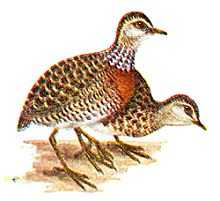Plains-wanderer
| Plains-wanderer | |
|---|---|
 | |
| Conservation status | |
| Scientific classification | |
| Kingdom: | Animalia |
| Phylum: | Chordata |
| Class: | Aves |
| Order: | Charadriformes |
| Family: | Pedionomidae Bonaparte, 1856 |
| Genus: | Pedionomus Gould, 1841 |
| Species: | P. torquatus |
| Binomial name | |
| Pedionomus torquatus Gould, 1841 | |
The Plains-wanderer (Pedionomus torquatus) or Plains Wanderer, is a bird, the only representative of its family. It is endemic to Australia. The majority of the remaining population are found in the Riverina region of New South Wales.
Description
The Plains-wanderer is a quail-like ground bird, measuring 15–19 cm. The adult male is light brown above, with fawn-white underparts with black crescents. The adult female has a distinctive white-spotted black collar. They are poor flyers, preferring to run when startled. Females lay four eggs, which the male then incubates.[2]
Taxonomy
It was formerly believed to be related to the buttonquails and thus placed in the gamebird order Galliformes or with the cranes and rails in Gruiformes. DNA-DNA hybridization and RAG-1 sequence data places it as a wader related to the jacanas (Sibley & Ahlquist 1990, Paton et al. 2003, Thomas et al. 2004, van Tuinen et al. 2004). It thus represents a remarkable case of morphological convergence, or perhaps it is simply extremely plesiomorphic in morphology (the buttonquails, meanwhile, having turned out to be a very basal offshoot of the wader radiation). In the latter case, this would mean that the jacanas, painted snipe and seedsnipes – all ecologically very different birds – all evolved from birds very similar to the living Plains-wanderer.
Status and conservation
Population decline has been caused by the conversion of native grasslands to cultivation. Sites identified by BirdLife International as being important for Plains-wanderer conservation are Boolcoomatta, Bindarrah and Kalkaroo Stations in north-eastern South Australia, Diamantina and Astrebla Grasslands in western Queensland, Patho Plains in northern Victoria and the Riverina Plains in New South Wales.[3]
International
This bird is listed as an endangered species on the 2007 IUCN Red List.
Australia
Plains Wanderers are listed as vulnerable on the Australian Environment Protection and Biodiversity Conservation Act 1999 (EPBC). Their conservation status also varies from state to state within Australia. For example:
- The Plains Wanderer is listed as threatened on the Victorian Flora and Fauna Guarantee Act (1988).[4] Under this Act, an Action Statement for the recovery and future management of this species has been prepared.[5]
- The Plains Wanderer is listed as endangered on Schedule 1 of the 'Threatened Species Conservation Act (1995).
The Plains Wanderer is likely to change status to nationally endangered under the EPBC Act 1999.
References
- ↑ BirdLife International (2012). "Pedionomus torquatus". IUCN Red List of Threatened Species. Version 2013.2. International Union for Conservation of Nature. Retrieved 26 November 2013.
- ↑ Archibald, George W. (1991). Forshaw, Joseph, ed. Encyclopaedia of Animals: Birds. London: Merehurst Press. p. 101. ISBN 1-85391-186-0.
- ↑ "Plains-wanderer". Important Bird Areas. BirdLife International. 2012. Retrieved 2012-11-04.
- ↑ Department of Sustainability and Environment - information on status
- ↑ Department of Sustainability and Environment - Action Statement
- Paton, T. A.; Baker, A. J.; Groth, J. G. & Barrowclough, G. F. (2003): RAG-1 sequences resolve phylogenetic relationships within charadriiform birds. Molecular Phylogenetics and Evolution 29: 268-278. doi:10.1016/S1055-7903(03)00098-8 PMID 13678682 (HTML abstract)
- Sibley, Charles Gald & Ahlquist, Jon Edward (1990): Phylogeny and classification of birds. Yale University Press, New Haven, Conn.
- Thomas, Gavin H.; Wills, Matthew A. & Székely, Tamás (2004): A supertree approach to shorebird phylogeny. BMC Evol. Biol. 4: 28. doi:10.1186/1471-2148-4-28 PMID 15329156 PDF fulltext Supplementary Material
- van Tuinen, Marcel; Waterhouse, David & Dyke, Gareth J. (2004): Avian molecular systematics on the rebound: a fresh look at modern shorebird phylogenetic relationships. Journal of Avian Biology 35(3): 191-194. PDF fulltext
External links
| Wikimedia Commons has media related to Pedionomus torquatus. |
| Wikispecies has information related to: Pedionomus torquatus |
